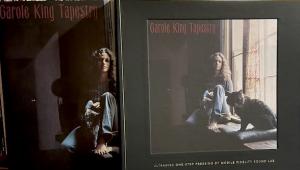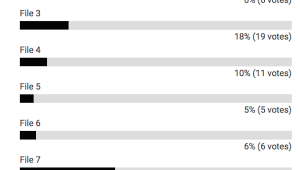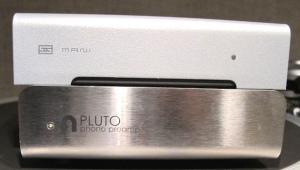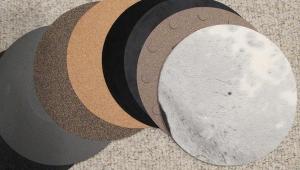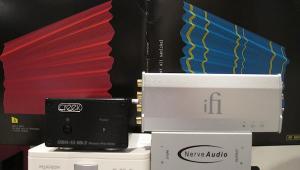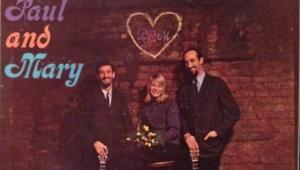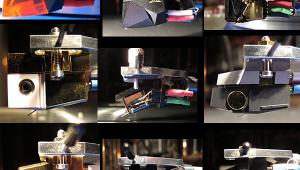I also thought that Mofi's recent one-step reissue of Janis Joplin's Pearl didn't sound as good as their earlier 2lp, 45 rpm version...it appears not all One-Steps are created equal. Thanks Michael!
The "Tapestry" Reveal!
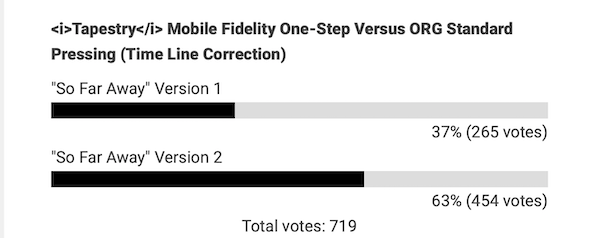
You could buy them or once you found out they were CD sourced and cut by “A. Nonymous”, ignore them so no harm done, right? Not quite. The 4 Men folks had excellent and adventurous musical tastes. Often, the label would sign a longterm licensing deal that blocked for many years more serious “cut from tape” players from producing an AAA reissue of the same title. Sometimes, but not often, a competing label could get the license but only for a double 45rpm reissue.
I can’t remember specific titles but I recall asking Mobile Fidelity, Analogue Productions and Classic Records about some attractive reissue titles only to be told that 4 Men had it “locked up” for a long time.
I cite this background to explain why I chose to run this Tapestry comparison. It’s not to “embarrass” anyone though I only embarrassed myself by whining that Mobile Fidelity had stopped sending me promo records when for the most part they had not. The “pipeline” had shut down releases so despite announcing a boatload, including “One Steps” of the Eagles and Van Halen catalogues the label had not actually issued them.
Tapestry had been released and no promo arrived—and I don’t call asking where’s “my” copy— so when a reader generously offered to send one, I accepted the offer.
Over the decades the various iterations of Mobile Fidelity—starting in the 1970s when Herb Belkin founded the company, to when it exited and then re-entered the vinyl business under Belkin with the Anadisc 200 series and then onto the new ownership—have had their share of spectacular successes and occasional failures. I’ll just list some successes: Beck’s Sea Change, the entire Elvis Costello and Miles Davis catalogues and I could go on. The One-Steps got off to an equally spectacular start with Santana’s Abraxas and the more recent Monk’s Dream.
I’m not going to list the failures but most of them, starting with the original Japanese “Super Vinyl” series back in the late ‘70s had “smiley face” EQ—boosted bass and treble leaving a midband valley “suckout”.
I thought the Mo-Fi mastering team had left that all behind—especially considering how deft was their work on Jeff Beck’s Truth — until I heard this Tapestry One-Step. And by the way I do have Mobile Fidelity’s “standard” 33 1/3 pressing (MFSL 1-414) mastered by Krieg Wunderlich assisted by Rob LoVerde and it’s a far more honest rendering of what clearly was not a great recording to begin with. They may have slightly “touched up” the bottom but only slightly, and the mids where King’s voice resides is full, rich, natural sounding only slightly impeded by whatever touch up they made on the mid-bottom. They made no attempt to add “fairy dust” on top so the mix remains coherent honest and “is what it is”. It’s a 100% successful reissue IMO.
It seems that the pressure was on (real or imagined) to make the “One Step” more better but instead….well “Version 1” is the One-Step and “Version 2” is the ORG. 63% to 37%—and not because the One-Step was cut “less hot” so the 2dB or so volume difference tilted the playing field.
AnalogPlanet readers preferred “Version 2” for the same reasons I did. It’s there in the comments, though a minority preferred the One-Step.
Circling back to the top of this story: Mobile Fidelity has “locked up” some really great titles and just in case they’re all not cut, plated and waiting for press time—and for future licensed titles—please give music fans what’s on the tape—minor touch ups always allowed—but please do not try to create some new sensation in order to justify the “One-Step” process and price. Give fans what's on the tape, not a “reimagining” that attempts to make it better than it is. And if when you play the tape, it sucks, either because it wasn’t that great in the first place, or the tape has deteriorated, especially with a costly “One Step”, pass! That goes for every reissue label.
Speaking of which, some readers think I “have it in” for Mobile Fidelity and am somehow “allied” with Analogue Productions, so here are two 1 minute files: one an original pressing of John Lee Hooker’s Serves You Right To Suffer (Impulse A-9103) obviously at 33 1/3 and the other the Analogue Productions double 45 from 2010 in a deluxe package. I’d have passed! No vote this time, but which do you prefer and why? And which is which? (There is a level difference necessitated by my A/D converter).
- Log in or register to post comments


I bought the one step being a retarded ok boomer purchaser. Lemming like behavior as I have if not a first press than damn close and hadn't pulled it and spun it in ages.
Didn't do the comparison as I didn't care. The one step is quiet and nice but if someone wants it for 125 played twice it will be down the road.
The one step Fragile and Abraxas are killer good and love em.
I have the one step Pearl and love it as well but have never heard the 45 rpm cut but if it is the equal of the AP 45 rpm Doors re-issues than it would be a giant killer pressing.
Have Fun and keep them spinning.
Have

I had never heard this track. I don't have a lot of John Lee Hooker in my collection. I found file one far more dynamic and alive. File 2, I thought, sounded a bit muted, and was less compelling. If I owned 2 I would have enjoyed it with nothing to reference. 1 really grabbed me.

File 1 sounds artificially bright. (Though I always have some reservations about judging via my iPad.)

I'm just curious as to why. I don't know if MoFi/MD collects money at the pre-order stage or not. I find it interesting.

When pre-ordered Pearl on MoFi's site, my card was charged when I placed the order. When I pre-ordered all of the other One Steps on MD my card is authorized when the order is placed, but not charged until the title actually ships.

File 1 clearly has more ambiance but File 2 has better bass and drive. It all mostly lies in the drums and I could take either one but Im guessing the AP is File 2 as they avoided bass back in the day. It may be a little drier, but it doesnt sound as bad as you make it out to be to my ears Michael.
By the way I level matched them myself using ReplayGain.

Prefer track 1. Adjusting for volume track 2 sounds a little more muffled and flatter than track 1. Bass was a little punchier on track 2 but overall track 1 was more engaging. Go out on a limb here and say that Track 1 is the Original pressing 33-1/3.

More extended HF content. Clearer vocal. Using AKG 701 cans.


I don't have the previous MoFi at 33, but I have had the Classic and an OG. The OneStep is FAR more vibrant, alive.
No one but the mastering engineer or anyone who has actually heard the master tapes knows what is on them, and what is an "honest" rendering of what's on the tapes. Tonally, King's vocals and piano both seem more full and natural to what we expect, but that's not necessarily what's on the master tapes.
I refer y'all to the OneStep of Bill Evans' great Sunday At The Village Vanguard. The AP 45, which I also have along with an Alto 33, renders a fuller sounding Evans piano. Steve Hoffman acknowledged that the piano was thin sounding on the tapes and he plumped up the frequencies to make it sound fuller. But in the process, the frequencies he boosted ended up muddying the bass. The OneStep, in contrast, while a bit thinner in tonality, reveals the definite pitch and quick transients of LaFaro's bass, making it much clearer the notes and rhythm he is playing, and the interplay between him, Evans, and Motion, the drummer. Musically, the OneStep makes more sense of the music.
So back to Tapestry, it's never going to be a demo quality recording. What it is, and recording notes tell you this, that they were set up in a less than prime studio, which meant a lower quality piano. The engineers wanted it to sound rough, as if jamming. The result is a very good recording of a demo type performance. The instruments are relatively dry. Yes, the piano is thin and trebly. The kick drum really slams on the OneStep. There's much greater spaciousness between the instruments. The OneStep sounds more alive than either the Classic Records copy or the OG.
I'll mention that a reviewer in Positive Feedback magazine, probably my favorite audio review publication, absolutely loved what MoFi did with this OneStep of Tapestry. He rated that the MoFi 33 got about 85% of the OneStep. High praise. And both are better than the Classic. But the OneStep give a sense of life to the music and instruments that aren't quite there on the MoFi 33.

I just judged the two files on my computer with external speakers/subwoofer (cheap) but better than nothing. I preferred File 2, the first thing I noticed was that the acoustic guitar was 'more' obvious and that her voice seemed to be about right in the mix. Overall I just preferred the overall presentation of File 2.
Regarding 4MenWithBeards I have two titles, Dusty Springfield's Dusty In Memphis and Terry Reid's River. Their sleeves were of a good standard, a pity one couldn't say the same about the sound. I got rid of Dusty in Memphis, but I kept the Terry Reid River because I have never come across it on vinyl, actually never saw a copy of it anywhere.
For me personally asking the high price for the One Step's is just beyond my means, so I leave the conversation about their prices to others.
I was also shocked at the way some people responded to Michael's challenge of 'preferring' one file over another, totally deviating from the subject matter. Years ago I made a comment to Michael about a double LP I had bought (with sides 3&4 in the sleeve twice) without going into the details, Michael sorted me out and I live thousands of miles away.
For me, I just love to get informed about what is becoming available, what is available, what sources were used, who was involved in the LP cutting/mastering and Michael gives that information in spades.
James, Dublin, Ireland
James, Dublin, Ireland

There are quite a few copies of the LP on Discogs, although the Near Mint ones are somewhat pricey. Excellent album!
https://www.discogs.com/sell/list?master_id=190954&ev=mb&format=Vinyl&co...

I admit, as I mentioned in an earlier post above, that I evaluated these two files on inexpensive computer speakers. However, even then, I knew which file was the One Step. Is that good or bad? Well, one may say I was hearing the "hi-fi" smiley curve of the remastering engineer's EQ choices. Yes, that is somewhat true, but in this situation, those EQ choices made for a better rendering, in my humble opinion, of that song. And as Analog J states above, who "really" knows what the master tape sounds like. Is it more faithful to file 2 or the mofi on File 1? At the end of the day, we must pick the one that makes us smile. Since I don't have both vinyl copies to actually play on my system, I have to go with the file that made me smile and say, "Ahhh, that's better!" And for me, that was file 1.

It's important to judge merely what something sounds like in terms of re-creating the sound of an instrument and musical qualities. They may or may not equate.
There are limited frequency hifi systems that, in spite of them being limited, do an incredible job of conveying a performer's push and pull of dynamics and tone. We know that a musical instrument when getting louder doesn't just get louder, but it tends to get fuller in physical air volume put out. There's a swell. When we hear an orchestra or a string quartet, they don't just get louder but they fill the space more. That's, again, about physical air volume.
There are also characteristics such as transients, the nimbleness in the rendering of the music. Is the start and stop of a trumpet precise and quick, or is it sort of mushy. This quality has little to do with how full the instrumental tone is, but rather, it's more about pace, quickness.
So, going back to the Sunday At The Village Vanguard OneStep vs the AP 45, the OneStep far better conveys the musical intent, the interplay of the players. But I'll grant that Evans' piano sounds fuller or more what we think of as a normal sounding piano on the AP.
But unless a mastering engineer can go back to multi-track session tapes (if they exist) where he/she can alter the individual recording of each instrument, the engineer will screw up the sound of one instrument to fix another. Boosting certain frequencies boosts them for all instruments. LaFaro's bass sounds better on the OneStep (As I mentioned, it sounds a bit thick and a bit muddy on the AP). So Steve Hoffman fixed the piano, but in the process messed up the bass.
With Tapestry and its recording flaws, and with Wunderlich only having access to the stereo master tapes, if he were to fix the piano and vocal (which previous engineers seem to have tried to do), he'd end up also altering any frequencies that rendered room ambient acoustics, the spatial representation, perhaps the transients and pitch specificity, etc. Who knows?
But I can tell you in my hifi system, as tonally flawed as Carole King and her piano are on certain cuts (some cuts sound much better than others), most of the other instruments sound better, including the bass and the drum kit. There's a MUCH greater sense of the room with the OneStep, and the instruments within it. And the kick drum has both greater precision as well as impact.
I used the following line in another forum: Rather than the OneStep being an excellent demo recording, it's an excellent recording of a demo. And from the recording notes I read, it's the latter what the recording engineers were going for. (King knew and mentioned the lesser quality of the piano in the room, and that the room wasn't the ultimate in a recording studio, but the engineer was going for a loose, spontaneous jammy sort of feel.).

A bit late to the party, but:
Great, great album, Tapestry.
The files are very different. In many ways, Apollonian and Dionysian "accents" come to mind: "1", the One Step, holds some restrained, structural beauty, though it's rather detached, emotively. "2", the ORG, is more raw, intimate and intense ("you" is really soo far away).
Both files have qualities and some sonic quirks in their respective efforts, it would seem, for separation and unity, but most days I would definitely play file 2. The ORG simply plays more "addressed", to message and to listener, and the motion in my headphones feels more music-infused, to me.
Thanks for impressive needle drops, Michael. And thanks for giving your take.

Is any sound benefit of the 45rpm versions so much it's worth getting up and down every 12 minutes or so? From my experience where I have both versions, made during the same mastering session, I just find the 45's just a little louder. I have heard MoFi may be offering 33rpm One Steps in the future.

I remember I owned the WB 33 RPM rerelease of Fleetwood Mac's Rumours and I bought the 45 RPM on a whim, thinking "how much better could it sound?"
I sold the 33 RPM version the next day; it wasn't a trivial difference.

is that the 45 is louder. Level can easily fool people though, guessing why people prefer the ORG Tapestry as well.

Both 33 and 45 Hoffman mastered versions pressed at Pallas. The 45 is just louder that's all. The 33 sounds the same IMO outside the "loudness"

Assuming the 33 and 45 are otherwise similar, the marginally better sound on the 45 is not worth it, unless maybe you have a system like Michael’s. Not only is there the hassle of changing sides/records, this format undermines the integrity of the album, which was designed to be listened to as two sides.

would if anything make the 45 even more useless. Since it wouldnt have the 33 suffer any issues due to the lower speed, making them more equal. Still the 45 would be louder of course.

File 2 had a more cohesive soundstage to me, vocals were more vibrant, but the whole sound had kind of a muddied overtone. It would be the clear winner if it didn't sound so "subterranean". Now I'll read some of the other replies.

I've bought a few 1-Step's from a couple of sources: Dylan 'Blood On The Tracks' (MoFi 45 rpm), Pat Barber 'Cafe Blue' (Impex 45 rpm), and Irma Thomas 'Love Is The Foundation' (Newvelle 33 rpm). They all sound great on mine and a friend's mega $$$ system but overall, I am underwhelmed with the whole process. Too much other stuff just to enjoy for me to sink any more cash into these sort of releases.

It was a bit hard for me to get past the level imbalance, but File 1 sounded, on my desktop system, much more open and clear than the somewhat muddied File 2 which was completely unengaging to my ears.

I listened to File 2 second and initially thought, "Wow! This is really ... " And then, "Uh oh wait a second. No no no no."
Unlike the King samples, on the Hooker I'm not yet convinced it comes down to definition. I mean, here there are obvious EQ choices being made, especially for File 2. A red flag in my opinion.
On File 2 it's obvious bass was boosted. On File 1 it's a mere suggestion. Problem: Both the kick drum and bass guitar/acoustic bass are over modulated mush and by boosting it, both instruments are revealed to suck. Just ... don't. Sins of omission are always preferred, thanks.
File 1 has a more upfront, and "appropriate" (I think) ride cymbal. In real life that should come through clearly without being artificial, and I think it succeeds here.
But forget the extremes. File 2 appears to have an excellent delineation of the guitar at the very beginning of the sample, however when things get busy in that 20-30 mark right before the vocal, I'm not so sure there are as many meaningful differences. Again, it just may there isn't much "there" there?
File 1 on my setup sounds more balanced. If File 2 turns out to be the better take, I'd have to seriously re-jigger my EQ --- throwing off most of my library --- to reveal any hidden nuggets for File 2. Voice and guitar, when it gets busy, just don't come through as well as in File 1.
I want John Hooker in my room, and the rest remains secondary.
I suspect what happened here is that for File 1 they worked with what they had to enhance it, whereas for File 2 they said, what if bass made everything better and we just assume the rest will be OK?

Just compare the Mofi Bill Evans Portrait in Jazz with the AP45 and the Alto 33. Both better. But Village Vanguard Mofi is great as is the Monk. Just listen.

“I cite this background to explain why I chose to run this Tapestry comparison. It’s not to “embarrass” anyone though I only embarrassed myself by whining that…” —Was one of these sourced from a Red Book original as mentioned further up? If not what embarrassment can it be for readers? (Is that who is meant by “anyone”?)

Michael,
I know, a slight side track here, but have you heard the One Step of Folk Singer?
Up to the AP 45 or better?

The AP

The AP

The AP

The AP has better top end openness, a hell lot more reverb echoing to the left side and also elsewhere more ambience Information than the 1step.
Although the 1step is much quieter and cut wider, the AP sounds as if processed on a better chain.

I concur with the above . The muddy waters one step is the best sounding version . Better then the AP and even the clarity classic records 45 .

Is that they are not important enough to me to purchase multiple versions. I'm fine with the classic Folk Singer since I don't listen to it on a regular basis. Dark Side of The Moon?...I'm buying every version that I can

I have the Analogue Productions 45 and the Classic 33.
With the MoFi one-step on the way.
I'm glad to hear it's worth it.
Thing is, pretty much everything I have from MoFi in the last 10 years has been great. From the Sinatras through to the Knack. It's all been just great stuff. I really liked recently the Dylan "Blood on the Tracks" one step. In all it's slightly speeded up (mostly side 2) glory.
Not a huge fan of "tapestry", have a couple of original Asylums, but it would hardly get played.
Now, if Muddy Waters "Folk Singer" gets the one step treatment, how about the Rolling Stones Corporation opening the vault and doing a one step of "12 X 5" ??? !!!! Most of that record was recorded in the Chess studios, using the same equipment as was used for the Folk Singer sessions. You want to hear one well recorded track, track down the stereo 45 7" of "It's All Over Now". It's a blast. Same sonics as Folk Singer.

Almost all of my six one step records I own are not flat. Some of them bump so much they can not be played at all. My retailer contacted Mofi several times about the bad press quality. Unfortunately he did not get a serious answer.

This article does a great job of shedding light on the real issues behind vinyl reissues and why provenance and mastering quality matter so much to collectors. I hadn't realized how much influence labels like 4 Men With Beards had by locking up rights, sometimes preventing higher quality AAA versions from being made for years. The comparison with Mobile Fidelity's catalog and their fluctuating mastering choices is really informative. As someone who chases after both the best sound and the joy of collecting, it’s a bit like playing Snow Rider 3D—sometimes the ride is smooth and thrilling, other times you hit unexpected bumps due to behind-the-scenes decisions. I appreciate how this piece digs into specifics rather than just complaining about reissues, helping vinyl lovers make better informed choices.

